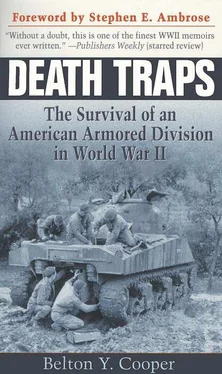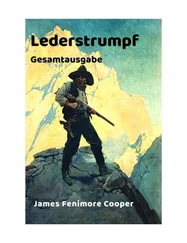Thus, this coin was carried by five different American soldiers, in five different American wars, and they all survived without being killed or seriously wounded. I believe this is unique, and is the only coin in existence that has had this history.
APPENDIX I – Panzers Versus American Armor
The M4 Sherman that we took into Normandy weighed thirty-two tons and had two and a half inches of armor, inclined at forty-five degrees, on its front glacis plate. It had a short-barreled, low-velocity (2,050 feet per second) 75mm gun. Later, about 15 percent of the tanks we received had the new 76mm gun with a higher muzzle velocity (2,650 feet per second).
When the war began in Europe, a confused debate was raging between American tank designers in ordnance and senior officers in the army ground forces. In the summer of 1939, when I was at Aberdeen Proving Ground as an ordnance cadet, our main battle tank was the M2A1 medium tank with a 37mm gun mounted in the turret. After the Germans invaded Poland in September, the debate became more intense. The armored and cavalry officers favored a large-caliber, high-velocity antitank gun mounted in the turret. The infantry officers still thought of the tank as an infantry assault weapon. The artillery officers thought that if a tank was going to carry a gun larger than a 37mm, the gun should conform to artillery specifications, which required a gun to be capable of 7,500 service rounds in combat. To meet this, a 75mm gun and larger would require a relatively low velocity. It apparently never occurred to the artillery officers that few tanks would ever survive in combat long enough to fire 7,500 service rounds. The result of this was the new M3 battle tank, designed by a committee.
This committee chose the new tank’s basic features. It had the M2A1 lower hull and track system, powered by the R975C1 400-horsepower radial engine, and a transmission and final drive similar to that of the old M2A1. The side and frontal armor were increased, and an angular-shaped hull was devised using riveted connections. The front glacis plate, approximately two and a half inches thick, started out at forty-five degrees where it connected with the transmission and extended about halfway up the front. It then had a knuckle riveted joint in the middle and extended upward at about sixty degrees. The riveted joint was used because some officers felt that the welding would weaken the armor plate. This decision was disastrous.
When a small-caliber, armor-piercing bullet struck the head of one of these rivets, it sheared it off and drove the internal part of it into the tank, where it ricocheted like a projectile and killed the crew.
The committee decided to put a 37mm antitank gun in the turret, coaxial with a .30-caliber machine gun. The 37mm was already obsolete and had practically no effect on the frontal armor of German tanks. The turret also had a .50-caliber ring-mount, dual-purpose machine gun. The main armament, conforming to the artillery board’s specifications, was a low-velocity 75mm M2 gun mounted in a barbette enclosure on the right side of the tank. With approximately forty-five degrees of lateral traverse and its low muzzle velocity (2,050 feet per second), it seemed to satisfy the infantry board as a good assault tank.
The tank had a much higher silhouette than any comparable German tank and could be easily spotted from a considerable distance. To make matters worse, the committee was apparently dominated by Yankees, who decided to name this tank the “Grant,” after the Union general and later president. The Southerners were aggravated further by the later naming of the M4, known as the “Sherman,” after the Union general who burned a path through Georgia.
Opposing us were three types of German panzers. The PzKw IV, which we usually called the Mark IV, weighed twenty-three tons and had four inches of vertical armor on the front and a high-velocity (3,000 feet per second) 75mm gun. Next came the PzKw V Panther, weighing fifty-three tons with three and a half inches of armor on the front glacis plate at thirty-eight degrees, below the critical angle of ricochet. The Panther carried a long-barreled, high-velocity (3,300 feet per second) 75mm gun. Finally came the PzKw VI King Tiger, weighing sixty-four tons with six inches of armor at forty-five degrees on the glacis plate and a long-barreled, high-velocity (3,250 feet per second) 88mm gun. The German tanks had a qualitative superiority of as much as five to one over our M4 Sherman.
The combination of superior firepower and heavier armor allowed the German tanks to engage and destroy the M4 Sherman at long range. There were many cases where Shermans would score multiple direct hits on the front of a Panther or a Tiger, only to see the shells bounce off harmlessly. In comparison, the German high-velocity guns could not only penetrate the lighter armor of the Sherman with a single shot at long range, they could knock out a Sherman even after shooting through a brick wall and, in at least one instance, by shooting through another Sherman tank:. Whereas the Sherman had to get within six hundred yards of a Panther and hope to catch it on the flank, the Panther could knock out a Sherman at two thousand yards head-on.
Before the Normandy invasion, some U.S. armored commanders assumed that because the Sherman was lighter than the Panther, it would be more mobile. This assumption was incorrect. The key to a tank’s off-road mobility is its ground bearing pressure: how the weight of the tank is distributed over the ground. Because the Panther had a wider track than the Sherman, it actually had a lower ground bearing pressure and could go places where the Sherman could not. More importantly, the narrow track on the Sherman could not negotiate muddy terrain and snow.
The M4 Sherman’s inferiority was by no means predestined; we enjoyed a great superiority in other weapons systems. After a twenty-year period of isolationism between the wars, in just four years the United States was able to produce superior weapons in vast quantities, including rifles, artillery, motor transports, and aircraft.
As the only officer in the maintenance battalion who had been to the tank maintenance school in Fort Knox, I was knowledgeable about tanks, particularly their technical capabilities. At tank school, I took copious notes and read every field manual I could get my hands on. I also read any G2 ordnance reports we had on German tanks. Unfortunately, this information was limited. I saw no reports on German tanks larger or more powerful than the PzKw III and the PzKw IV with the short-barreled 75mm howitzer. We had no information about the German Panther tank, either, although I had read a newspaper account of the Tiger tanks that were used in North Africa against the 1st Armored Division. Because the M4 Sherman, with the 75mm gun in the turret, was far superior to the old M3, and because our knowledge of comparable German armor was limited, we felt that the M4 was a good tank.
Meanwhile, the Germans were replacing all the short-barreled 75mm guns on their Mark IV tanks with higher velocity guns, and they were developing the Panther and Tiger. The Sherman could not compare with these.
American tank designers also failed to give proper consideration to the latest Soviet advances in armor. Their medium T34 and heavy Josef Stalin tanks were both equipped with more powerful guns, heavier armor, and wider tracks than the M4 Sherman.
The U.S. Army did finally develop the M26 Pershing tank, with heavier armor and wider tracks than the M4, and with a long-barreled 90mm gun. This tank was far superior to the Sherman and would have placed us on a more level playing field with the German armor. However, due to the arrogance of certain high-ranking officers it was recommended that this tank be given a low priority, and production concentrated on the M4
Читать дальше












